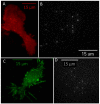Live-cell imaging of single receptor composition using zero-mode waveguide nanostructures
- PMID: 22668081
- PMCID: PMC3397148
- DOI: 10.1021/nl301480h
Live-cell imaging of single receptor composition using zero-mode waveguide nanostructures
Abstract
We exploit the optical and spatial features of subwavelength nanostructures to examine individual receptors on the plasma membrane of living cells. Receptors were sequestered in portions of the membrane projected into zero-mode waveguides. Using single-step photobleaching of green fluorescent protein incorporated into individual subunits, the resulting spatial isolation was used to measure subunit stoichiometry in α4β4 and α4β2 nicotinic acetylcholine and P2X2 ATP receptors. We also show that nicotine and cytisine have differential effects on α4β2 stoichiometry.
Figures




Similar articles
-
Roles of nicotinic acetylcholine receptor beta subunits in function of human alpha4-containing nicotinic receptors.J Physiol. 2006 Oct 1;576(Pt 1):103-18. doi: 10.1113/jphysiol.2006.114645. Epub 2006 Jul 6. J Physiol. 2006. PMID: 16825297 Free PMC article.
-
Structural characterization of binding mode of smoking cessation drugs to nicotinic acetylcholine receptors through study of ligand complexes with acetylcholine-binding protein.J Biol Chem. 2012 Jul 6;287(28):23283-93. doi: 10.1074/jbc.M112.360347. Epub 2012 May 2. J Biol Chem. 2012. PMID: 22553201 Free PMC article.
-
[Crystal and molecular structure of cytisine salts].Przegl Lek. 2012;69(10):998-1003. Przegl Lek. 2012. PMID: 23421078 Polish.
-
(-)-Cytisine and derivatives: synthesis, reactivity, and applications.Chem Rev. 2014 Jan 8;114(1):712-78. doi: 10.1021/cr400307e. Epub 2013 Oct 11. Chem Rev. 2014. PMID: 24117010 Review. No abstract available.
-
Cytisine: a natural product lead for the development of drugs acting at nicotinic acetylcholine receptors.Nat Prod Rep. 2012 May 1;29(5):555-67. doi: 10.1039/c2np00100d. Epub 2012 Feb 27. Nat Prod Rep. 2012. PMID: 22367109 Review.
Cited by
-
Photoluminescence Enhancement, Blinking Suppression, and Improved Biexciton Quantum Yield of Single Quantum Dots in Zero Mode Waveguides.J Phys Chem Lett. 2021 Apr 8;12(13):3303-3311. doi: 10.1021/acs.jpclett.1c00450. Epub 2021 Mar 25. J Phys Chem Lett. 2021. PMID: 33765768 Free PMC article.
-
Förster resonance energy transfer (FRET) correlates of altered subunit stoichiometry in cys-loop receptors, exemplified by nicotinic α4β2.Int J Mol Sci. 2012;13(8):10022-10040. doi: 10.3390/ijms130810022. Epub 2012 Aug 10. Int J Mol Sci. 2012. PMID: 22949846 Free PMC article.
-
Mammalian Cell-derived Vesicles for the Isolation of Organelle Specific Transmembrane Proteins to Conduct Single Molecule Studies.Bio Protoc. 2018 May 5;8(9):e2825. doi: 10.21769/BioProtoc.2825. Bio Protoc. 2018. PMID: 30406159 Free PMC article.
-
Mixed metal zero-mode guides (ZMWs) for tunable fluorescence enhancement.Nanoscale Adv. 2020 Mar 25;2(5):1894-1903. doi: 10.1039/c9na00641a. eCollection 2020 May 19. Nanoscale Adv. 2020. PMID: 36132495 Free PMC article.
-
Current approaches to studying membrane organization.F1000Res. 2015 Nov 30;4:F1000 Faculty Rev-1380. doi: 10.12688/f1000research.6868.1. eCollection 2015. F1000Res. 2015. PMID: 26918150 Free PMC article. Review.
References
Publication types
MeSH terms
Substances
Grants and funding
LinkOut - more resources
Full Text Sources

